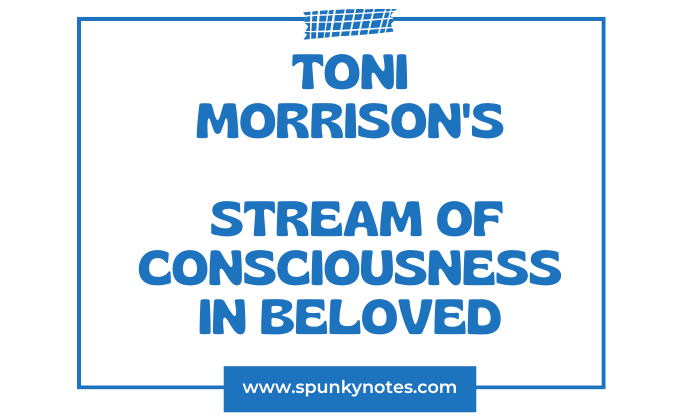
Q. How does Toni Morrison’s use of stream of consciousness in Beloved differ from William Faulkner’s use of the same technique in The Sound and the Fury?
Q. How does Morrison’s writing style affect the presentation of the story? Consider her use of stream-of-consciousness and nonlinear narrative.
Introduction
Toni Morrison’s Beloved is not traditionally categorized as a stream-of-consciousness novel in the same vein as works like James Joyce’s Ulysses or Virginia Woolf’s Mrs Dalloway.
However, it is crucial to explore how Morrison employs the stream-of-consciousness technique in “Beloved” to convey her characters’ trauma.
What is Stream of Consciousness?
Stream of consciousness is a narrative mode that attempts to capture a character’s innermost thoughts, feelings, and reactions. It is often in a continuous flow and without conventional punctuation or syntax.
This technique dives deep into a character’s psyche, presenting thought processes in a raw, often nonlinear fashion.
Stream of Consciousness in Beloved by Toni Morrison
1- Nonlinear Timeframes
In “Beloved,” one of the most striking aspects that resembles the stream of consciousness technique is the nonlinear time frame. In a traditional narrative, events are usually told chronologically, making it easier for readers to follow the storyline.
However, Toni Morrison intentionally defies this convention. Instead of providing a straightforward recounting of past events, Morrison allows the narrative to shift seamlessly between the present moment and various points in the past. This approach closely resembles how human memory functions, especially when trauma has shaped it.
For Sethe, the past is not a closed chapter but a persistent presence that resurfaces in her current life. She does not experience her memories as isolated incidents neatly segmented from her present; they are part of her living reality.
The nonlinear narrative illustrates how past and present are entangled in her consciousness. It makes it impossible to consider one without the other.
For instance, Sethe’s memories of Sweet Home, where she was enslaved, often intrude without warning into her daily life. These are not just flashbacks but fragments of lived experience that inform her current identity, decisions, and emotional state.
This blending of time frames is particularly effective in conveying the inescapable nature of traumatic memory. When traumatic events are recalled, they often do not follow a linear or logical pattern; instead, they impose themselves abruptly and overwhelmingly into one’s current consciousness.
That is precisely what happens to Sethe. Using a nonlinear time frame, Morrison brings readers closer to Sethe’s psychological reality. It vividly conveys her ongoing battle with memories that resist being neatly organized or forgotten.
2- Intimate Access to Characters
Using a narrative style akin to stream of consciousness in “Beloved” grants readers intimate access to revealing and unsettling characters. In a traditional third-person narrative, a clearly defined distance is often maintained between the characters and the reader.
However, in ‘Beloved,’ that distance is shortened considerably. Through Morrison’s masterful storytelling, we enter the inner sanctums of the characters’ minds, exploring their deepest fears, traumas, and longings as if they were our own.
When Sethe remembers the abuse she faced at Sweet Home or her desperation to protect her children, we do not just learn about her feelings. We almost feel them ourselves.
This closeness enables us to understand her complex decision to take her daughter’s life to spare her from the horrors of slavery.
Morrison does not just tell us that Sethe is anguished; she lets us into Sethe’s consciousness to feel the tangled emotions of love, fear, and desperation that lead her to such an extreme act.
This intimate portrayal also extends to other characters—Denver’s crippling loneliness, Paul D’s battle with his sense of manhood, and even the enigmatic thoughts and desires of Beloved herself.
The stream of consciousness-like access to their inner lives turns them into more than just characters in a book; they become complex individuals whose emotional and psychological complexity is laid bare for the reader to witness and ponder.
This profound intimacy enhances our engagement with the story and deepens our understanding of the character’s choices and their intricate humanity.
3- Interweaving Narratives
The interweaving of multiple narratives in “Beloved” is another characteristic that echoes the stream of consciousness technique.
A typical novel has a single, dominant point of view, but “Beloved” defies this norm. Instead, the book jumps between different perspectives. It allows for a multifaceted, almost kaleidoscopic view of events and experiences.
This does not just add complexity to the storytelling; it also mirrors the complexity of human consciousness and the shared yet individual nature of trauma and memory.
Take, for example, the different ways Sethe, Denver, and Paul D remember and interpret events from their pasts. Sethe’s traumatic memories of Sweet Home and her escape from slavery coexist with Denver’s isolation and Paul D’s experiences in a chain gang.
Although characters share the same physical space, such as the house on 124 Bluestone Road, each has a unique emotional experience.
Their worlds may overlap, but they remain distinctly different in how they feel and think. In the story, different characters react to the same events in their ways. This is like how people’s thoughts and feelings can be similar but also different in real life.
4- Language and Syntax
In “Beloved,” Toni Morrison’s word choice and sentence structure are similar to the stream of consciousness style. To show raw feelings and thoughts, Morrison uses specific words, sentence styles, and punctuation. The way she writes makes it feel like we’re right inside the characters’ minds.
Her language is a powerful medium to delve deep into her characters’ psychological and emotional complexities. It reflects their fractured states of mind and struggle to understand their tumultuous pasts.
For instance, consider Sethe’s recollection of her traumatic experiences. The syntax often breaks down into fragments:
And the minute she saw the dress and shoes sitting in the sun next to the pump… she flew. The ice pick was not in her hand; it was her hand.
In ‘Beloved,’ Toni Morrison uses broken and jumbled sentences to show Sethe’s intense and chaotic feelings. Regular, straightforward sentences would not capture the power of Sethe’s experiences. The mixed-up writing style lets us dive directly into Sethe’s mind and feel her emotions.
Furthermore, Morrison often employs repetition and non-standard grammar to emphasize particular emotional states. Phrases like “They took my milk” recur like obsessive thoughts, underscoring Sethe’s intense feelings of violation and loss.
Through these choices in language and syntax, Morrison creates a narrative that mimics the rhythms of inner thought. It captures not just what characters are thinking but how they are thinking.

